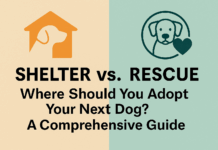Last Updated on November 4, 2024 by Dogs Vets
Dogs are often friendly and playful, but children may not understand how to safely approach or interact with them, especially when the dog is unfamiliar. While many dogs are gentle, even the calmest animals can react unpredictably if threatened or overwhelmed. Supervising children around unfamiliar dogs is essential for preventing potential incidents and teaching kids how to interact with pets safely. With guidance and careful supervision, children can learn to enjoy the company of dogs without putting themselves or the dog at risk.
Understanding canine behavior and boundaries is important, particularly for children who may not recognize the warning signs of discomfort in a dog. Adults can help create a safe environment by monitoring interactions and stepping in when necessary, ensuring the child and dog feel secure. Supervision is critical in protecting young children from potential bites or scratches and teaching them lifelong skills for respectful animal interaction.
Recognizing Signs of Discomfort in Dogs
Dogs often communicate discomfort through body language, such as lowered ears, a tucked tail, or growling. Teaching children to recognize these signals is an important part of safe interaction. Explain to kids that when a dog backs away, looks away, or exhibits other signs of discomfort, it’s a signal that the dog needs space. Recognizing these cues helps children avoid actions that might cause a dog to feel threatened or defensive.
Adults should step in immediately if they notice a dog showing signs of stress around a child. Supervising interactions enables parents or guardians to redirect the child’s behavior and guide them toward gentler, safer ways of engaging with dogs. Understanding a dog’s body language helps prevent misunderstandings and keeps both the child and dog safe.
Teaching Children to Approach Dogs Properly
It’s crucial to teach children how to approach dogs in a way that respects the animal’s comfort and space. Children should be encouraged to ask the dog’s owner for permission before petting and to approach slowly, extending a hand for the dog to sniff before petting. Quick movements or loud sounds can startle dogs, so teaching a calm, gentle approach is essential.
Children can also learn to avoid touching a dog’s face, ears, or tail, as these are sensitive areas that may trigger a defensive reaction. By supervising these interactions, adults can ensure children approach dogs safely, promoting a positive experience for both the child and the dog.
Establishing Boundaries for Safe Interaction
Establishing boundaries around dog interactions helps children understand that dogs have personal space, much like people do. Teach children to respect a dog’s space when it’s eating, sleeping, or playing with a toy, as these are times when a dog may be more protective. Boundaries are essential for preventing accidental bites or scratches, particularly with unfamiliar dogs.
Supervising allows adults to reinforce these boundaries and step in if a child gets too close during sensitive moments. By establishing these guidelines, children learn to respect dogs’ needs and comfort levels, which contributes to safer and more enjoyable interactions.
Modeling Respectful Behavior Around Dogs
Children often model their behavior after the adults around them. Demonstrating respectful behavior around dogs sets a positive example, showing children how to treat animals with kindness and understanding. Approach dogs calmly, speak softly, and avoid sudden movements to illustrate how to interact respectfully.
Modeling appropriate behavior around dogs helps children internalize these lessons and apply them in their own interactions. When adults consistently demonstrate respect for a dog’s comfort and space, children are more likely to follow suit, creating safer experiences for everyone involved.
Educating Kids on the Difference Between Play and Aggression
Children may mistake certain behaviors as playful, even when they indicate discomfort or aggression. Educating kids on the difference between playful actions, like wagging tails, and warning signs, such as growling or raised hackles, is important for safe interaction. Explain that some dogs play by chasing or barking but that certain actions signal the dog may need space.
Clear guidance on these distinctions helps children understand when it’s safe to engage and when it’s best to step back. Supervision allows adults to provide immediate feedback, helping kids learn in real-time how to read a dog’s behavior accurately and make safer choices.
Ensuring Adult Supervision at All Times
Direct adult supervision is essential whenever children are around unfamiliar dogs, as it provides an immediate safety net if the dog becomes uncomfortable or the child behaves unpredictably. Even well-behaved dogs can react defensively if startled, and an adult’s presence can quickly de-escalate any potential issues. In the unfortunate event of a dog bite or injury, consulting with Miller & Steele Personal Injury Lawyers can help families understand their options and protect their rights.
Adults can intervene if a dog starts showing signs of stress or if the child unintentionally oversteps boundaries. Ensuring constant supervision helps prevent accidents and teaches children to approach dogs with caution and respect, creating a safe environment for both.
Encouraging Positive Reinforcement and Patience
Positive reinforcement helps children learn appropriate behaviors around dogs in a supportive way. Praise children for calm, respectful actions, such as petting gently or waiting for the dog to approach. Encouraging patience shows kids that dogs need time to feel comfortable around new people and that interactions should never be forced.
Positive reinforcement makes the learning process enjoyable for children, and they’re more likely to remember respectful behaviors when rewarded. Adults play a crucial role in fostering this learning environment, reinforcing safe interactions with positive feedback and patience.
Knowing When to Avoid Interaction Altogether
Sometimes, the best course of action is to avoid interaction with an unfamiliar dog altogether. Dogs may be in stressful situations or have a history that makes them less predictable with children. Teaching kids to respect a dog’s need for space and recognize when a dog might not be friendly is essential for their safety.
If there is any uncertainty about the dog’s temperament, it’s best to observe from a distance. Adults can help children understand that not all dogs are open to interaction and that respecting an animal’s boundaries is part of being a responsible pet lover.

















